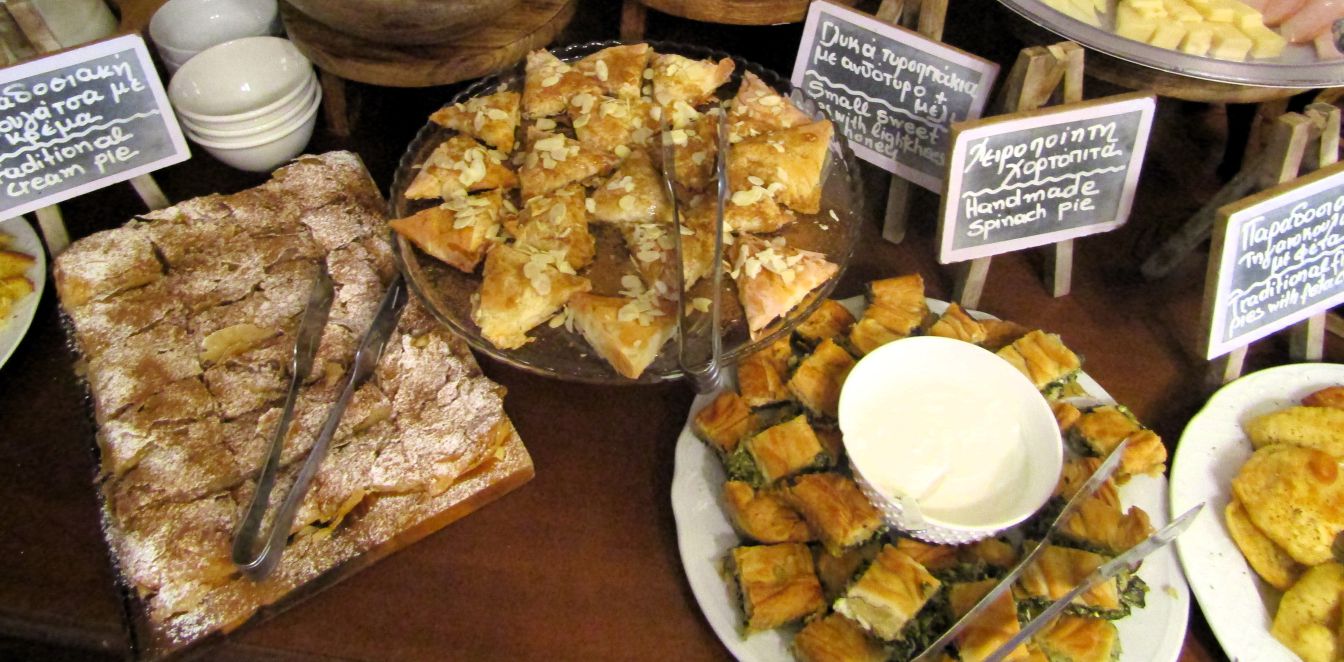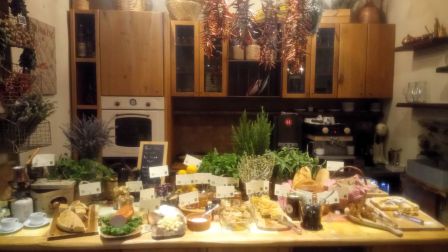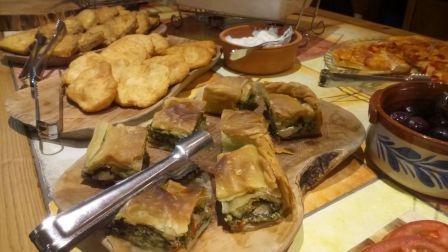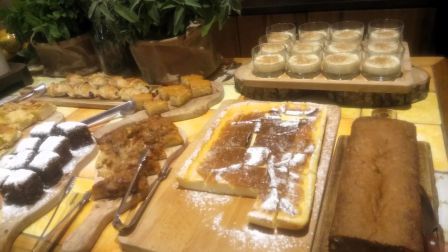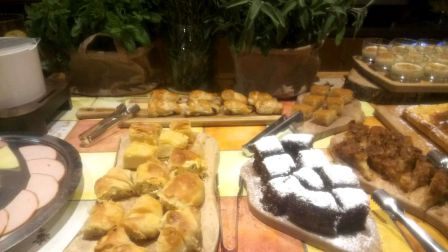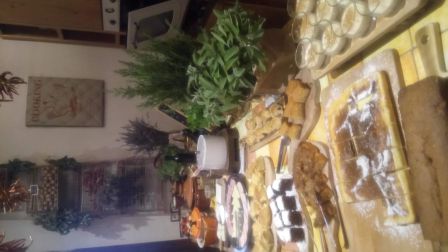Greek pies are so much more than just a dish. They are a cultural heritage, a symbol of Greek hospitality, and a gastronomic delight that has been preserved unchanged for centuries. From ancient times, when pies were often offered to the gods as a sign of gratitude for the harvest, to our days, when every celebration and family meal seems to be accompanied by a pie, the tradition is vividly kept alive. Essentially pastries, with or without dough, simple or complex, quick or time-consuming, with various fillings, sweet or savory, fasting or festive, depending on the region. Throughout Greece, we encounter similar pies with different names that depend on the place and the products that housewives used to have at home, making pies to feed the family.
In every Greek region, the pie has its own unique variation. The ingredients may change depending on the seasons and local production, but the essence remains the same: fresh, quality ingredients, real flavors, and a lot of love in the preparation.
From the kneaded dough that requires skill and patience to the rich filling that often consists of simple, but flavor-rich, ingredients of the Greek land, the pies reflect the Greek ability to turn the simple into something marvelous.
In many areas in Greece in the old days, a serious criterion for a girl to become a bride was that she had to know how to masterfully open a thin dough and to make intricate designs on bread and the decoration of cookies.
It was a saving solution for housewives, as they put in for their children at school, for their husbands at work, or a piece for dinner with a sage or chamomile. Grandmothers in the mountain villages where snow was common made dry pies. From spring when the various herbs came out tender, until autumn they gathered herbs, which they made into bunches, and dried them in a well-ventilated shady place. Then they put them in fabric bags or pillowcases that they had salted. That is, they had dipped them in a solution with a lot of salt, they had dried up and thus put the dried herbs inside, protecting them from insects. Later, when they wanted to make a pie in the winter, they just soaked them in water and they were ready to use as if fresh.
In most parts of Greece, we have pies that do not have dough but instead use a cornmeal slurry. And you had to be a craftsman to properly bake the corn slurry, so it would make a crunchy crust on top and inside the herbs were ready. And let's not forget that in the old days, pies were baked in a clay pot with a rounded lid, inside nestled coals. They placed the pie, and covered it around and also on top with coals to have a uniform baking. Later they baked pies in the stove, and finally, in today's era in the electric oven.
Whether sweet or savory, each pie has its own story to tell, a story full of aromas, flavors, and the Greek tradition that continues to live through its simple recipes that pass from generation to generation. Each cooking and every bite is a journey through time and space, starting from ancient Greece and reaching up to modern Greek tables.
They are not just part of the diet but a piece of Greek identity. At every celebration, observance, or meeting, the pie has its honor. At Christmas, Easter, even at engagements or weddings or baptisms, pies always have a place. It represents generosity, community, and prosperity. The process of opening the dough, preparing the filling, and cooking with patience and care is a form of expressing love.
With a multitude of traditional recipes that are as luxurious in taste as they are simple in execution, pies are the food that accompanies Greeks from the happiest to the most challenging times. It is an expression of Greek life, a life full of flavors, aromas, and the value of sharing.
The world moves forward and so does the way of processing dough. In today's era, there are ready-made dough sheets in commerce, which have solved our hands, because if we want to make a pie, we just make the filling, and the dough is ready for us to proceed with our pie for baking. But if we want to make the dough ourselves, there are kitchen machines that will knead the dough nicely and effortlessly, so we can easily and quickly open our homemade dough.
The most widespread pies are tyropita (cheese pie), spanakopita (spinach pie), prasopita (leek pie), zambonotyropita (ham and cheese pie), bougatsa, milopita (apple pie), kolokythopita (pumpkin pie), etc. but let's not forget the traditional pies with local names, which have grown generations and generations.
Ultimately, Greek pies are not just a food, they are a gastronomic experience that one can find only in the rich and diverse Greek cuisine. Whether served warm and crunchy or cold as a snack, pies remain favorites in every Greek home and table. Let's take a closer look at some of them.
Flour Pie (Alevropita)
This is the easiest, quickest, and very tasty pie you can make since its ingredients are very few and basic in the house. It comes from Zagori and is the most common pie for breakfast, as an appetizer, next to a salad, for a snack, for afternoon tea, for dinner with tea, for school, for work, and more... It has only 4 ingredients and its taste is unforgettable. Flour, eggs, cheese, butter. It doesn't have a dough and is essentially a batter that we place in a baking dish and bake, resulting in a very thin and very delicious pie. I have also encountered this pie at the foothills of Olympus, in a village I visited (Rapsani), where they make it inside a wood-fired oven.
Egg Pie from Roumeli
Egg pie is a different kind of pie, which is enriched with eggs and cheeses. It is usually made during the Cheesefare Week since the great Lent is about to begin and they needed to use up all the eggs and cheeses to start collecting eggs for 40 days for the Easter egg dyeing. So, essentially, the egg pie was like a cheese pie with various cheeses inside but they put quite a few eggs, milk, butter, and of course traditional phyllo dough from the housewives who opened it intricately, making designs around the rim. It had its honorary place at the table since for 40 days they would not eat these ingredients again.
Vasilopita (New Year's Cake)
The pie of Saint Basil. We make it on the eve of the New Year and cut it as soon as the year changes. We will most often find the politiki (from Constantinople) and smyrneiki (from Smyrna) vasilopita. One is fluffy with spices and nuts, and the other resembles tsoureki (sweet bread), aromatic and very tasty. In Western Macedonia, in some villages instead of vasilopita, they have leek pie or cheese pie. In all versions, we have one common element. The coin that is placed inside for good luck of the year. The head of the household cuts the vasilopita, who will first cut pieces for Christ (and Virgin Mary), for Saint Basil, and for the poor.
Galatopita (Milk Pie)
The Messinian galatopita is the traditional dessert of the area. It is seen on festive tables, at Christmas, but also after Easter, as well as during the Cheesefare Week. Generally, we will encounter galatopites all over Greece, in many variations. With or without semolina, with or without phyllo, even a fasting version with almond milk.
Lesvos Giouzlemedes (Lesvos Cheese Pies)
Giouzlemedes are traditional fried cheese pies from Lesvos. Their name comes from the Turkish word "goz" which means eye, reflecting the small bubbles that form on their surface during frying. In Lesvos, they are found as a meze, accompanied by ouzo from Mytilene, served as an appetizer, in salads, and also in all homes where housewives make them in various shapes (triangles, squares).
Walnut Pie (Karydopita)
A traditional syrupy dessert that looks like a cake and contains walnut meal. We find it both in a fasting version and with butter. In our country, the distinguished one is the Gianniotiko walnut pie, famous for its deliciousness. Its appearance is dark due to the walnuts, as well as the spices such as cinnamon and the raisins. Often it is also found with a chocolate topping.
Cake
The cake is a sweet, fluffy dough that we bake in the oven. It's a favorite snack for all of us since we can make it at any time we want at home. It contains butter, milk, eggs, flour, and baking powder, and we bake it in round or rectangular molds. We find it in various flavors, such as banana, lemon, chocolate, vanilla, orange, etc. As a type of cake, we can also include wedding cakes, birthday cakes, or festive cakes like Christmas, Carnival, Easter cakes which we adjust in flavor according to the occasion.
Epirus Pie (Kothropita)
A supreme pie!! An unusual pie, I might say, which the Epirotes made with boiled meat and rice. The meat could be lamb, veal, or even chicken. They boiled the meat, then shredded it, keeping the broth. They opened a dough sheet, placed the meat around the edge, covered it with the dough, and in the middle, they put rice with the meat broth. They baked it in a hot oven, and the whole house smelled wonderful. A festive pie, seen at Christmas tables, weddings, baptisms, etc.
Savory Pumpkin Pie (Kolokythopita)
The savory pumpkin pie is made with green zucchini, grated and well-drained, with the addition of feta or myzithra cheese. Wonderful as an appetizer or snack. It can be found with various herbs to give flavor and aroma, embraced and baked with crispy phyllo dough or handmade country-style dough.
Sweet Pumpkin Pie.
The sweet pumpkin pie is made with the orange pumpkin. After it's grated and drained, it's baked with raisins, nuts, and various spices such as cinnamon and clove, in a delicate, crispy dough or in handmade country-style dough. We encounter it more in winter because pumpkins start to be collected from late autumn. Thus, the sweet pumpkin pie is particularly beloved by children due to its wonderful taste, and it is a staple at every Christmas table!
Chalkidiki Lazy Pie (Kolombaropita)
Known as the "lazy pie" in Chalkidiki, it's something between a pie, batzina (savory pumpkin pie), tart, and sfougato (omelette pie). It's an easy pie where you don't need to open a dough sheet, and the housewives made it to quickly feed their family with whatever ingredients were in the fridge, based on cornmeal. So, Kolombaropita would be made with various vegetables, cheeses, eggs, yogurt, etc.
Kourkouto (Cornmeal Pie)
It is a pie made with cheeses or vegetables, trachanas (soured wheat), without a dough sheet. To bind this pie, we use flour, milk, eggs, and the main ingredient (cheeses, vegetables, etc.) and bake it in the oven in a baking tray. Each place has its own version of the pie. In Metsovo, there is a wonderful pie with their smoked cheese combined with bacon and onion or leek.
Meat Pie (Kreatopita)
The meat pie is an international pie that we find in countless variations of meat types, cuts, combinations, pie shapes, and baking methods. In Kefalonia, there is the traditional meat pie with pork, beef, lamb, or goat combined with rice, tomato paste, and dough kneaded with wine. In Ioannina, Thrace, etc., they combined the meat with leek, onions, feta. That is, whatever each place produces more. As we see generally around the world, the meat pie has been adapted according to habits and material productions. For example, in India, we find meat pies where lamb or chicken was mixed with spices such as coriander, etc., making "samosa" enhanced with peas and lentils. In Latin America, the meat had intense spices, peppers, and they enhanced the filling with salami, cheese,egg, etc. In the Middle East, they use spices, tahini, tomatoes, pine nuts, yogurt, and usually beef in what they call "sfiha." In Australia and New Zealand, they enhance the meat with bacon and onions. In Germany, the meat pie has plenty of butter, and pieces from various sausages to enhance the flavor. Their meat is marinated with beer and served with cabbage.
Mykonos Onion Pie (Kremmydopita Mykonou)
A traditional pie from Mykonos, which includes both dry and fresh onions with plenty of dill and fennel, and the flavor is bound together with tyrovolia cheese. The pie is very aromatic, zesty, and is highlighted by the handmade phyllo dough.
Mani Lalaggia
Traditional Mani lalaggia are crispy dough strips fried in olive oil in a spiral shape. Housewives prepare them just before Christmas in the classic shape, as well as in festive shapes like stars, balls, crosses, etc. In Mani, you'll find them in every bakery or pastry shop, occupying a special place as they are consumed in large quantities. They are addictive once you start eating and are often offered as a treat in baskets.
Sausage Pie (Loukanikopita)
Loukanikopita, a dish said to have come from Germany, has become particularly popular and was a quick snack to satisfy hunger. The dough was made from village-style phyllo or a simple dough, where there were both fried and baked versions of the pie. There was a wide variety of sausages, so the combination of fillings produced excellent results. In addition to sausage, flavors were complemented by cheeses, cabbage, various sauces, and even leftovers from meals. Today, loukanikopitas come in a wide variety due to the variety of meat in the sausage, spices, and additional ingredients that make the sausage tastier.
Loukoumades
Loukoumades (lokma in Turkish, meaning bite) are made from a yeast dough batter. This popular sweet, spherical in shape, is served with chocolate, honey, cinnamon, syrup, or sugar. They are also known as "sfingi" by the Greek Jewish community who offered them as a Christmas dessert. In our country, they are made all year round, as a dessert, for afternoon snacks, and even for breakfast with honey and walnuts. We also have stuffed loukoumades with seasonal fruits.
Macaroni Pie (Makaronopita)
An easy pie that can be found with phyllo dough, as a batter, or even as a tart. Makaronopita was the housewife's solution to make a meal with whatever ingredients were in the fridge. Thus, we find makaronopitas with meat, vegetables, deli meats, cheeses, etc. A favorite for everyone is the village-style makaronopita with feta, bell peppers, tomatoes, and olives. Rolled makaronopita wrapped in phyllo or village-style dough is also common.
Mamaliga of Lamia
This is a traditional local pie made with pumpkin and feta. It's special because it doesn't have a dough sheet; it starts in a pot and is finished in the oven. It can be found with variations, such as with potatoes, trachana, etc., and with more than one type of cheese, giving Mamaliga its distinct taste.
Mushroom Pie (Manitaropita)
A divine pie made in Kastoria and Florina. It's prepared with fresh or dried mushrooms and handmade phyllo or puff pastry. It can be found in a fasting version, or with the addition of eggs or cheeses. The pies with various kinds of mushrooms are outstanding, offering an intense flavor.
Skirian Marmites
Marmites are pies made on the island of Skyros on the eve and the day of the Epiphany. There are fasting versions filled with raisins, pumpkin, walnuts, etc., and regular versions with myzithra or feta filling. According to tradition, the marmites were eaten by goblins, who reached in through the chimney (goblins could elongate their arm as much as they wanted) and, while singing, asked the housewives to give them the pie, which they took and left. Marmites are traditionally baked on bricks or onions in the fireplace but are now also baked in ovens.
Eggplant Pie (Melitzanopita)
A distinctive pie with a devoted following, thanks to the eggplant which gives a special aroma and taste. Melitzanopita can be found with a wonderful combination of bell peppers, usually in its fasting version, but also with feta which blends wonderfully, as well as with various cheeses. The phyllo for melitzanopita is always village-style, handmade.
Mykonos Honey Pie (Melopita Mykonou)
A traditional pie from Mykonos made with tyrovolia, the fresh cheese of Mykonos. It's a fragrant, sweet pie loved by all. In almost all our islands, we have similar honey pies, such as in the Cyclades, where they make honey pie with their own cheese, and the base only has phyllo dough at the bottom, in Crete with sweet myzithra cheese, etc.
Apple Pie
A pastry that can be seen both as a covered pie with an apple filling and as an open tart. Its country of origin is England, where it is made with grated dough for the base, and the filling on top covered with dough strips creating patterns. In our country, wonderful apple pies are traditionally made in Pelion. The apple pie can be found in many variations: as a pie with an apple, walnut, and cinnamon filling; as a tart; as a cake with apple pieces; upside down; as a batter. The filling, besides apple, includes walnuts, raisins, spices, and of course, it's always accompanied by a scoop of ice cream.
Baklava
Baklava is a favorite dessert that has come to us from the Middle East. It has a filling of nuts, covered with very thin phyllo dough, and is drenched in sugar syrup or honey. It has been a PDO product of Turkey since 2008. In our country, the Baklava of Kymi is particularly distinguished and is famous throughout Greece. The special feature of Kymi Baklava is the many layers of phyllo dough interspersed with layers of almonds, and its syrup is rich in honey. The layers should be no fewer than 70. It is satisfying, tasty, and delightful, rightfully holding the first place in baklava in Greece.
Babanetsa
A traditional pie from Roumeli, made with various herbs, cornmeal, and cheese. It is an easy pie, and as they characteristically say, it is the pie of the lazy. It doesn't have a top layer of dough, but the ingredients are spread in the pan and bound together with a cornmeal batter, creating a golden crust on the top of the pie. It is baked in the oven and can be enjoyed at all times!
Gianniotika Batsaria
The simple herb pie of Ioannina, with basic ingredients such as cornmeal, or plain flour, milk, and eggs. It is eaten hot or cold, accompanied by yogurt. The herbs are those that were abundant in the area, such as dock leaves, spinach, wild greens, fresh green onions, dill, parsley, and of course, crumbled feta cheese, which gave the pie its flavor.
Preveza Blatsara
Blatsara is a local pie that is made quickly and easily. It is made with various herbs, spices, fresh green onions, and cheeses. It does not have phyllo dough but is made with a cornmeal batter. A favorite pie for housewives as it was made very quickly and was an everyday pie on the table for breakfast, afternoon snack, or dinner with tea.
Bougatsa
Bougatsa refers to the phyllo dough with which the pies are made. Famous bougatsas in our country can be found in Serres (where the largest bougatsa in the world was made, which entered the Guinness Book of World Records in 2008) and in Thessaloniki. The word bougatsa is a corruption of the Turkish word pogaca, which means dough. There are many pies made from bougatsa dough, such as with cheese, minced meat, spinach. However, we all associate bougatsa dough with cream, with plenty of powdered sugar on top and cinnamon. The chocolate cream bougatsa is also very tasty and has been particularly loved.
Boureki
Boureki is a type of thin, delicate phyllo dough that we fill and roll up to create a small tube. We can find bourekis sweet or savory. Its origin is from the East and has been adopted and loved by all of us. In Greece, the famous Chaniotiko boureki is filled with potatoes, zucchini, and myzithra cheese. Also well-known are the Cypriot "zambousies," which are bourekis (pourekia) filled with poppy seeds, fennel, and yellow squash.
Mesolongi Brikopita
Brikopita is an extremely tasty pie based on chicken meat (we may also see it with wild duck or pork meat). The village phyllo dough is made with the addition of cornmeal, which becomes the base for the pie, and the filling, besides the chicken, includes eggs, cheeses, and finally, it is covered with a cornmeal batter made with the broth
from the boiled chicken.
Cretan Myzithropita
The Cretan cuisine is known as one of the healthiest and most balanced, contributing to longevity. Thus, they make various varieties of myzithropita. There is the sweet myzithropita, the savory, the watery, the Sfakian with honey, the individual myzithropitakia, and of course, the myzithropites made in a frying pan. They are served plain, with honey, powdered sugar, nuts, sesame, and many other accompaniments.
Macedonian Papaftia
Papaftia are small pies filled with minced beef, plenty of onion, and dough made from bread, which they rolled out into sheets, filled with the mince, and fried in hot butter.
Potato Pie (Patatopita)
A type of pie with village-style phyllo dough, crust, or with a batter, which has a filling of potatoes and spices. It is more commonly found during fasting periods and is made in all parts of Greece, appearing as a classic pie, as a rolled boureki, as a tart, as a batter, and even in a roll.
Pontic Perek
Perek are very crispy leaves made only with flour and water. They knead them and cook them on a "sats" (a metal tray - a sheet of metal) that sits over the fireplace, spread the batter very thinly, and let them dehydrate completely. They would store them in a dark, well-ventilated place, and when they wanted to make pies, they would wet them slightly, butter the leaves with feta, and bake them.
Piroshki
Piroshki are fluffy, fried small oval pastries with various fillings. The traditional piroshki is made with potato, but we also find them with minced meat, egg, mushrooms, feta cheese, cream cheese, ham and cheese, sausage, or even cabbage. The sweet version is with various jams or spoon sweets. A traditional Russian-Ukrainian dish that has been loved by all.
Thessalian Plastos
Plastos is a traditional, quick, and easy pie from Thessaly which is made with various herbs, leeks, spinach, or cheeses and instead of phyllo, it is cooked with a cornmeal batter.
Rice Pudding (Rizogalo)
Rizogalo is a creamy dessert based on rice and milk. It is served in small bowls with a sprinkle of cinnamon. It is made in a pot, but baked rice pudding is also excellent. Rice pudding is made in many countries around the world, and in some, it is a characteristic Christmas dessert.
Rice Pie (Rizopita)
Rizopita comes in two versions, savory and sweet. It was an easy solution for a filling family meal as the housewives used whatever was in the fridge in the past. Meat, vegetables, cheeses, legumes, deli meats, even part of the leftover meal. Each place has its own rice pie that has been paired with the local products it produces. Rice pies from Karditsa, Mytilene, Serres, Thessalian, Sarakatsanian, Kozanitiki (or the bride's boureki), Cretan... all have their peculiarities. The Cretan, since we mentioned it, the rice was boiled in chicken and lamb broth, and they also added a few pieces inside the rice as well as stakovoutyro (a type of butter).
The sweet rice pies could contain pumpkin, or nuts, spices, honey, etc. The sweet rice pie could also be found in a fasting version.
Sarikopites
Sarikopites are small, twisted cylindrical pies made with xynomizithra cheese, accompanied by honey, toasted walnuts, cinnamon, sesame, and raki. They got their name from "sariki," a woven white or black headscarf worn by Cretans with tassels hanging on the forehead (tears). The dough for the phyllo, besides flour, salt, and olive oil, also includes raki.
Spinach Pie with Cheese (Spanakopita me tyri)
Spanakopita is usually enriched with feta cheese. It is made all over Greece with crusty phyllo dough, village-style phyllo which housewives skillfully open, or even without phyllo using a batter made from flour and eggs. A very common version is also the twisted spanakotyropita. The cheese is usually locally produced, and with the combination of spices and herbs, the spanakotyropita of each place has a unique taste. The cheese we add inside is usually crumbled feta, and the ratio varies from place to place and from housewife to housewife.
Spanakopita (Spinach Pie)
Spanakopita is a type of pie with phyllo dough and a spinach filling, seasoned with aromatic herbs. There are many variations of spanakopita across different regions of Greece, where the type of phyllo or the filling changes, such as in Thrace where it's made twisted, or in Epirus where they use corn flour, etc. The filling also varies by location, depending on the local herbs available. The base consists of spinach, dill, and fresh green onions, and from there, flavor combinations can include eggs, rice, trahana, cheese, other greens, etc., changing the name of the spanakopita (spanakotyropita, spanakopita with trahana, with rice, etc.). You can also find spanakopita fried in olive oil, and in some parts of Greece, they make it without phyllo, using a batter made from flour and eggs.
Stegnopita Kozanitiki (Dry Pie from Kozani)
A traditional fasting pie from Kozani made with various greens (dock, spinach, poppies, etc.), leeks, rice, walnuts, and tahini.
Tzoulamas or Gioulamas of Crete
A distinctive traditional pie from Crete. Its filling includes raisins, nuts, rice, meat or liver, chicken hearts, (chicken, pork, lamb), and pine nuts. The flavor of this particular pie is unique as it's slightly sweetened with raisins and sugar, balanced with meat, and combined with the spices it contains (cinnamon – cloves, etc.). It's covered with thin handmade phyllo or crust phyllo. A traditional pie for Carnival, it's a dish recorded as a Messaritiko Tzoulamas.
Trahana Pie (Trahano?pita)
Trahano?pita is a distinctive pie that can be found in many variations, due to the fact that trahana comes both sour and sweet. Thus, it can be quite diverse with many combinations, with cheeses, vegetables, potatoes, tomatoes, as phyllo, as a batter, etc. It's a unique pie that each place makes with its own local produce, making it rare to encounter the same trahano?pita, as the vegetables, cheeses, or even milk (some use goat's milk) make a difference. Notable trahano?pita includes those from Pelion, Aetolia-Acarnania, Epirus, Arcadia, and the Cretan pie with sour trahana stands out as well.
Nettle Pie (Tsouknido?pita)
Tsouknido?pita is a special pie that, due to the highly nutritious ingredients of nettles, makes it one of the most nutritious pies. Since ancient times, nettles have always been on our table, as our people say in popular sayings, proverbs, and beliefs, "Ah, to be well, until spring, the season of greens and nettles." Nettle pies were made from St. George's Day until autumn. In winter, women made dry pies that had plenty of nettles as they dried them all year round, and in winter they wetted the nettles and made pies from them. It can be found with feta, with phyllo, but also without phyllo with a batter from cornmeal.
Tyropita (Cheese Pie)
Tyropita is a pie with cheese, found with village-style phyllo, crust phyllo or kadaifi, with a batter, kourou, or even rolled up like a boureki (kichi). In every part of Greece, tyropita is associated with the cheeses of the region, as well as with various variations due to local products. Popular tyropita is with feta cheese, but it can also be found with various cheeses combined with spices for a spicier flavor.
Fanouropita
A traditional sweet pie dedicated to Saint Fanourios. It is made on the day of Saint Fanourios and shared. The texture of the pie is like a cake but does not contain butter, eggs, milk because it is fasting, and it's enriched with raisins and walnuts. It is made to "reveal" an object, or it's made for the mother of Saint Fanourios who was a sinner and very harsh to poor people, as forgiveness and to have the saint's blessing.
Flaouna
Flaouna is a traditional Cypriot pie made on Holy Saturday, taken to church, and consumed after the Resurrection. In Arcadia, flaounes are also found and there, they are baked on coals. Ingredients vary from place to place, but the base is cheese. In Cyprus, they use grated halloumi with myzithra; in Arcadia, feta with graviera or kefalotyri, etc. Its flavor is enhanced with various spices and herbs such as mint, sweet anise, mahlab, mastic, but also with raisins and walnuts.
Cheese Pie with Greens (Chortopita me tyri)
Chortopita with cheese is a pie made with various greens - bitter, sour, sweet, aromatic - and is strengthened with local cheese from each region. Chortopita can be found with village-style phyllo, carefully and skillfully opened by housewives, or with ready-made phyllo, or crust phyllo, or even without phyllo, made with a batter from flour and egg. Chortopita comes in a baking pan, fried, twisted, and in individual small pies. The feta cheese added inside is grated, and often they enhance it with spices (various peppers) for a spicy flavor.
Chortopita (Greens Pie)
Chortopita is a pie with phyllo that contains all kinds of edible greens, along with herbs. You can encounter it with village-style phyllo opened by housewives, or with ready-made crust phyllo. It has a wonderful taste, and each place enriches it according to the greens it produces. The edible greens in a chortopita are classified into 5 categories:
Sweet: amaranth, lamb's quarters, nettles, blites, chenopodium, spinach, etc.
Sour: sorrel, vine leaves, etc.
Spicy: arugula, black mustard, etc.
Bitter: chicory, endive, dandelion
Aromatic: dill, fennel, mint, fresh oregano, parsley, etc.
To create a tasty pie, you need to maintain the balance:
40% a mixture of sweet greens
20% a mixture of aromatic herbs
10% a special category (sour, bitter, spicy)
20% fresh onions, dried onions, leeks.
And 10% that will enhance our pie with the flavor we want to give (possibly from the special categories).
Psiantra
Psiantra is the traditional greens pie of Messolonghi. It's made with various greens (chenopodium, wild mustards, lamb's quarters, spinach) and aromatic herbs, and the base includes traditional phyllo which the housewife opens, but the pie's topping is made with a batter and cornmeal.
Oatia Pontiaka (Pontian Ears)
A traditional Pontian dessert made from dough. They are distinctive for their shape as they are cut into diamond pieces and, by making a small hole in the middle and turning them over, they are fried. Thus, it resembles an ear (oti in Pontian). The oatia are like donuts or loukoumades and are served with honey or sugar and cinnamon.
LATEST RECIPES
GET LATEST UPDATES
Newsletter Subscribe
FEATURED ARTICLE

GET LATEST UPDATES
Newsletter Subscribe



